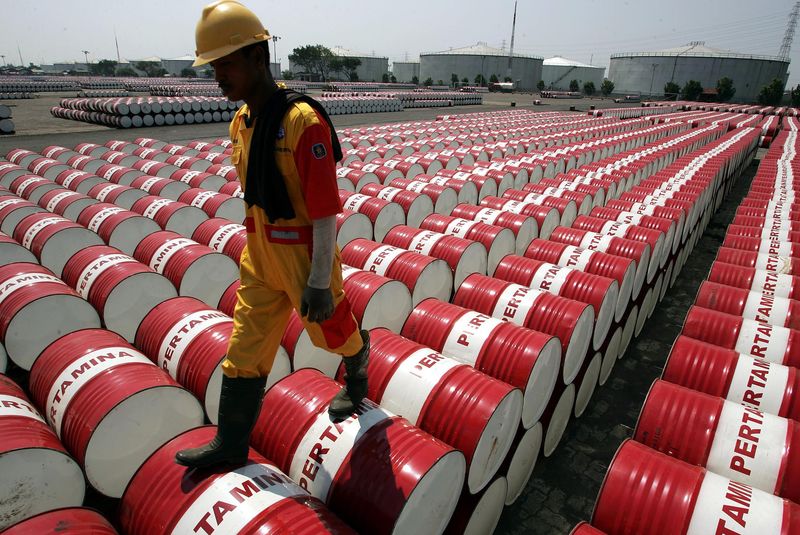By Catherine Ngai
NEW YORK (Reuters) - As a test of wills between OPEC nations and U.S. shale drillers fuels a global oil market slump, a brewing battle between Canadian and Saudi Arabia heavy crudes for America's Gulf Coast refinery market threatens to drive prices even lower.
While the stand-off between the oil cartel and U.S. producers of light, sweet shale oil has captured the limelight in recent months, the clash over heavier grades - playing out in the shadowy, opaque physical market - may put even more pressure on global prices that have halved since mid-2014.
Two factors will come into play over the next few weeks: From the North, new oil pipelines will pump record volumes of Canadian crude to the southern refineries, many better equipped to process heavy crudes than lighter shale oil.
From the Middle East, top exporter Saudi Arabia is offering crude at discounted prices in an attempt to defend its remaining share of the important regional market, which has shrunk by more than half in recent months.
"So far, the Gulf Coast has suffered from an oversupply of light oil, but now there's competition for heavier crude," said Sandy Fielden at RBN Energy. With the Saudis already facing fierce competition for their light grades, the arrival of Canadian crude "could add insult to injury", he said.
On Monday, Saudi Aramco stepped up its counteroffensive, cutting its monthly U.S.-bound price for Arab Medium for a sixth straight month, putting it at the deepest discount against the regional sour crude benchmark since December 2013. [OSP/SA].
The timing of this clash may magnify its market impact as Houston-area oil refiners shut down for maintenance in early spring, further reducing their demand by an estimated 1 million barrels a day (bpd).
"We'll see that overhang into the summer, at least," said one physical crude trader.
That will put further pressure on U.S. prices and may spur investors in New York and London to extend a sell off in crude futures.
SPOILT FOR CHOICE
The looming clash of barrels comes at a time when oil markets already face a global glut expected to last for a year or longer.
Large volumes of foreign heavy oil reaching the Gulf Coast will give many U.S. refiners more choice after they have upgraded their systems to process cheaper, heavier crudes. The new supply also marks a breakthrough in Canada's years-long effort to bring its growing Alberta oil sands crude output to new markets.
Enbridge Inc's (TO:ENB) 600,000 bpd Flanagan South pipeline, which runs from Illinois down to the Cushing, Oklahoma, oil hub began commercial service on Dec. 1; Enterprise Product Partner (N:EPD) announced that its 450,000 bpd Seaway Twin pipeline from Oklahoma to Freeport, Texas, shipped its first volumes on Dec. 21.
That promises another quantum leap for Canadian crude after its U.S. Gulf Coast sales already hit a record 274,000 bpd in October, nearly three times as much as a year earlier, according to U.S. data.
The new flows will compete with other crudes as well. Some refiners see Saudi's medium crude as a more direct substitute for Mexican and Venezuelan crudes.
However, some refiners are likely to blend oil sands crude with overabundant super-light U.S. condensate, creating medium blends that may rival Saudi Arabia's main grade, said Citi global commodities strategist Ed Morse. He warns the clash could set up another tumble in global prices.
The growing pressure on the Gulf market is already showing up in pricing and inventories.
Mars Sour
Crude oil inventories in the U.S. Gulf have risen to nearly 200 million barrels, a record high for late December and up some 15 percent from a year earlier.
The build-up comes as Saudi Arabia shifts its focus to fiercely defend what remains of its market in the United States - the world's largest consumer of oil.
Until recently, it seemed to be holding its own in part thanks to a major expansion of its joint-venture Motiva Enterprises refinery.
Saudi crude sales to the U.S. Gulf rose by a third to a record high of nearly 1 million bpd in the two years to 2012, a period where gushing shale production had begun to displace foreign suppliers.
But this year it has begun to lose ground, with shipments tumbling to 461,000 bpd in October, data from the U.S. Energy Information Administration showed.
Ironically enough, the decline was driven partly by a one-third cut in imports by Motiva, jointly owned by Saudi Aramco and Royal Dutch Shell (L:RDSa).
Other customers have also turned away. Valero Energy Corp's (N:VLO) cut imports by 85 percent in the first 10 months of 2014, with Saudi purchases falling to just 35,000 bpd, according to EIA data. Marathon Petroleum Co (N:MPC) cut Gulf Coast imports to 33,000 bpd in October from 205,000 bpd 10 months earlier.
While most Saudi customers agree on annual contracts with little room to reduce purchases, the Kingdom's state oil firm knows it needs attractive prices to retain long-term buyers.
"As refiners look at Canadian crude availability long term, they'll be thinking about ways to give themselves more options" said Richard Mallinson, an analyst at Energy Aspects in London.
(Reporting By Catherine Ngai; editing by Jonathan Leff and Tomasz Janowski)
